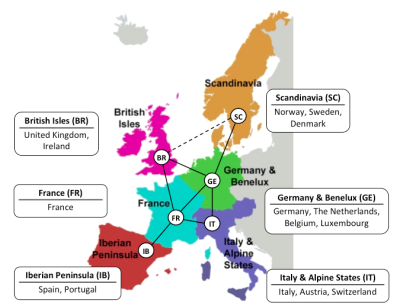ERP Conference: Managing Flexibility of the Electricity System
Date: Friday 27 November 2015
To mark completion of ERP’s flexibility project it teamed up with the Carbon Capture and Storage Association (CCSA) and the Zero Emissions Platform (ZEP) to host a conference on Flexibility and the Integration of Variable Renewables.
About 40 conference delegates were welcomed by Wilfried Maas of Shell and were introduced to the themes by Keith MacLean, Industrial Co-Chair of ERP. Peter Emery opened the conference with a short presentation on the background to ERP’s flexibility project. He highlighted how the project had examined the pressures on the grid with increasing penetration of weather dependent renewables and the impact its conclusions had had on modelling within DECC, the valuing of ancillary services and in moving the debate beyond levelised cost of electricity (LCOE).
Andy Boston of ERP went on to introduce the results and recommendations from the project. Firstly he demonstrated how it was essential that the firm capacity integral to any system was delivered by low carbon technologies, there was little room for unabated fossil other than for peaking duties. He made a plea that the value of non-energy services essential to grid operation was made more explicit to encourage new providers. Finally he argued that only a holistic approach could determine the value of a technology to the grid, simple metrics centred on the cost of energy could not deal with the effects of diminishing returns nor evaluate technologies that do not deliver energy.
 Greg Payne of E.ON pointed out that we were heading for seven simultaneous transitions of the electricity system! It’s neatly summed up in the graphic. These would evidence themselves in a market where the consumers’ capacity efficiency and flexibility were more important than energy efficiency. However he left us with lots of questions about the characteristics of a flexibility market which were yet to be determined.
Greg Payne of E.ON pointed out that we were heading for seven simultaneous transitions of the electricity system! It’s neatly summed up in the graphic. These would evidence themselves in a market where the consumers’ capacity efficiency and flexibility were more important than energy efficiency. However he left us with lots of questions about the characteristics of a flexibility market which were yet to be determined.
Mike Thompson of CCC presented modelling done to support the fifth carbon budget by NERA and Imperial College. This demonstrated the importance of developing flexibility for the grid otherwise targets for grid decarbonisation might be missed or costs significantly increased. They recommended that integration costs for technologies that demand great flexibility from the grid should be better reflected allowing flexibility sources to better capture their value.
Next John Tindal of SSE presented some of their modelling of the grid in the 2030s. After reminding the conference that economic modelling is mostly about understanding the question rather than giving the answer, he showed that although demand for flexibility would increase and traditional fossil suppliers would decrease there were a range of new suppliers that could deliver a highly flexible system that would allow UK to meet its carbon targets predominantly with wind and PV.
The morning presentations were concluded with a talk from Dr Niall Mac Dowell of Imperial College who examined the changing role of CCS plant from early life in the 2030s through to the 2050s. CCS plant could be well placed to provide flexibility but plant designers needed to be aware of this change of optimum design as the provision of ancillary services increased and CO2 capture and transport declined.
The speakers formed a panel to discuss issues raised during their presentations with the conference. The recent about-turn by the government on its support for the CCS demonstrations inevitably cast its shadow over these discussions as the conference tried to grapple with the implications of delaying or losing a key component of energy decarbonisation, as well as investor confidence in any new technology. Commonalities of the presentations were noted especially the need for holistic assessment of the value of technologies and recognition of the flexibility services they deliver or consume.
 After lunch a more international theme emerged opened by Anne-Sjoerd Brouwer, from Utrecht University who introduced the conference to some modelling encompassing much of Western Europe with 20-60% penetration of intermittent renewables. Although renewables increased costs and adding storage was expensive, demand response and interconnection were helpful and reduced integration costs. He echoed the morning’s conclusions that energy-only markets will not deliver necessary investments in firm capacity.
After lunch a more international theme emerged opened by Anne-Sjoerd Brouwer, from Utrecht University who introduced the conference to some modelling encompassing much of Western Europe with 20-60% penetration of intermittent renewables. Although renewables increased costs and adding storage was expensive, demand response and interconnection were helpful and reduced integration costs. He echoed the morning’s conclusions that energy-only markets will not deliver necessary investments in firm capacity.
Christian Skar from NTNU Trondheim described his experiences building an EMPIRE! In this case a dynamic capacity expansion model of Western Europe used as part of the ZEP work to examine high penetration of renewables. This demonstrated the criticality of CCS to EU decarbonisation, without it a carbon price of 100 €/t is insufficient to reach a 80 % reduction in emissions and the system had higher costs, higher prices and twice the emissions as the baseline.
Finally Dr Falko Ueckerdt, from the Potsdam Institute for Climate Impact Research described the components of integration costs for variable renewables. Profile costs (matching demand to load) were the largest and increased with penetration reaching €30/MWh when energy from wind exceeded 40%. Balancing costs were generally a few €/MWh and grid costs were more difficult to estimate given lack of data but were probably in the €2-13/MWh range. However integration costs for large grids and ones with significant amounts of storage could be significantly lower. As a result, wind and solar power are the most prominent option for decarbonising the global power sector, according to several global integrated assessment models.
The conference closed with a final panel of speakers who compared and contrasted their EU wide perspective with the GB system modelling presented in the morning. A larger system did make renewables integration easier and Germany’s success in expanding its renewables is in large part due to its ability to exchange energy across the EU system.
The presentations and debates concluded early afternoon and were followed by a workshop for modellers who joined a round table discussion group looking at the use of data, the presentation of results and bounding the scope the modelling.

 Biographies of speakers can be found below. The conference was supported by
Biographies of speakers can be found below. The conference was supported by
